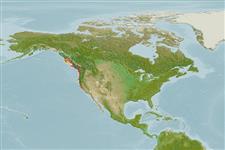Actinopterygii (ray-finned fishes) >
Perciformes (Perch-likes) >
Pholidae (Gunnels)
Etymology: Pholis: Greek, pholis, -idos = scale (Ref. 45335).
Environment / Climate / Range
Ecology
Marine; demersal; depth range 0 - 50 m (Ref. 56557). Temperate, preferred ?; 55°N - 36°N, 129°E - 122°W
Eastern Pacific: southern British Columbia to central California, USA. Authors giving range up to northwestern Pacific classify Pholis nea Peden & Hughes, 1984 as a synonym of Pholis ornata.
Size / Weight / Age
Maturity: Lm ? range ? - ? cm
Max length : 30.0 cm TL male/unsexed; (Ref. 2850)
Short description
Morphology | Morphometrics
Found in inshore areas, on mud bottoms among eelgrass and seaweed (Ref. 2850). Feeds on small mollusks and crustaceans (Ref. 2850). Both male and female guard egg mass (Ref. 2850).
Life cycle and mating behavior
Maturity | Reproduction | Spawning | Eggs | Fecundity | Larvae
Oviparous (Ref. 101786). Adhesive eggs attached to a nest substrate are brooded by both parents (Ref. 101786).
Eschmeyer, W.N., E.S. Herald and H. Hammann, 1983. A field guide to Pacific coast fishes of North America. Boston (MA, USA): Houghton Mifflin Company. xii+336 p. (Ref. 2850)
IUCN Red List Status (Ref. 115185)
CITES (Ref. 94142)
Not Evaluated
Threat to humans
Harmless
Human uses
More information
Age/SizeGrowthLength-weightLength-lengthLength-frequenciesMorphometricsMorphologyLarvaeLarval dynamicsRecruitmentAbundance
ReferencesAquacultureAquaculture profileStrainsGeneticsAllele frequenciesHeritabilityDiseasesProcessingMass conversion
Tools
Special reports
Download XML
Internet sources
